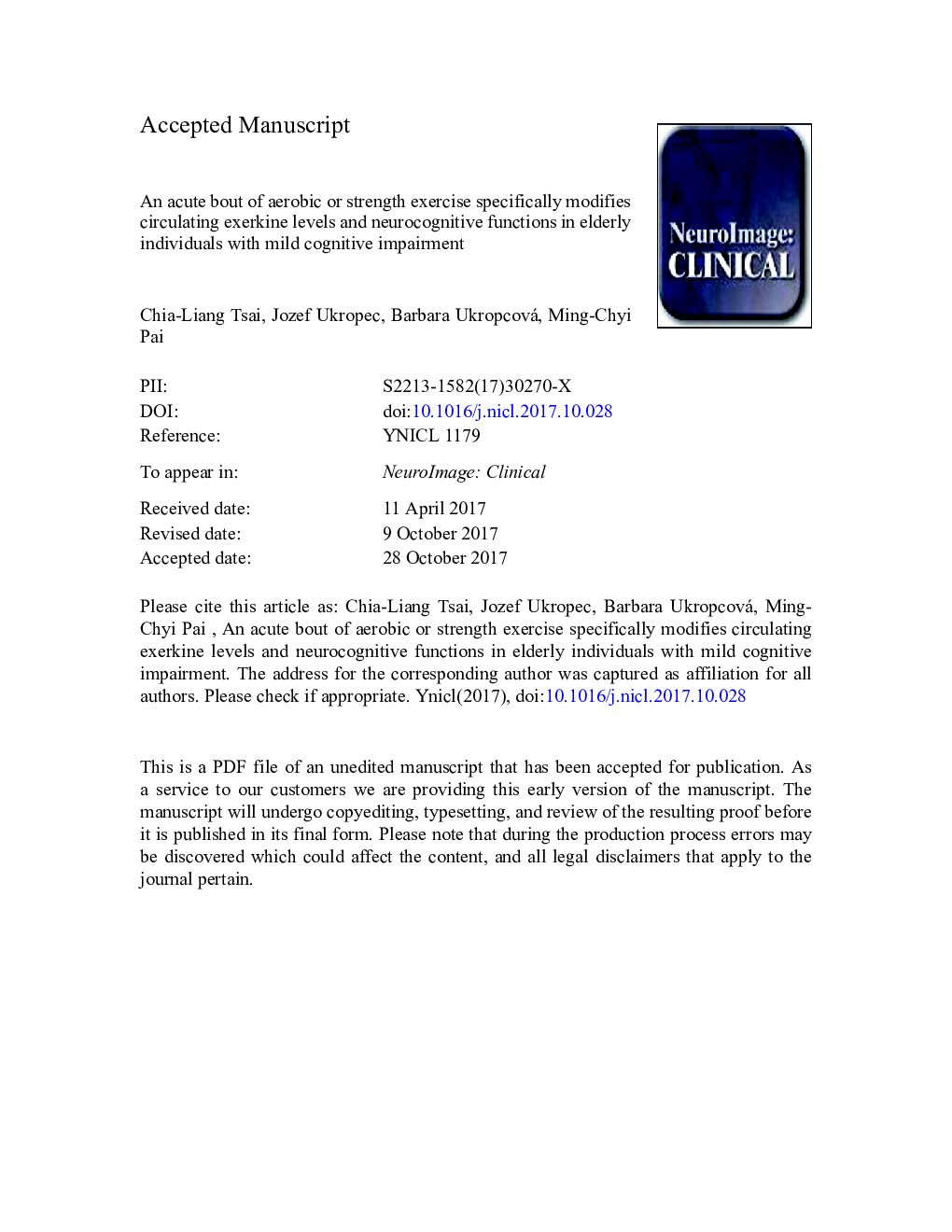| کد مقاله | کد نشریه | سال انتشار | مقاله انگلیسی | نسخه تمام متن |
|---|---|---|---|---|
| 8687920 | 1580950 | 2018 | 58 صفحه PDF | دانلود رایگان |
عنوان انگلیسی مقاله ISI
An acute bout of aerobic or strength exercise specifically modifies circulating exerkine levels and neurocognitive functions in elderly individuals with mild cognitive impairment
ترجمه فارسی عنوان
تمرین حاد تمرین هوازی یا تمرینات شدید به طور خاص موجب افزایش سطح عضلانی و عملکرد عصبی در سالمندان با اختلالات شناختی خفیف می شود
دانلود مقاله + سفارش ترجمه
دانلود مقاله ISI انگلیسی
رایگان برای ایرانیان
کلمات کلیدی
اختلال شناختی خفیف، شناخت، نوروتروفین، ورزش،
موضوعات مرتبط
علوم زیستی و بیوفناوری
علم عصب شناسی
روانپزشکی بیولوژیکی
چکیده انگلیسی
Although exercise is an effective way to decrease the risk of developing Alzheimer's disease, the biological basis for such benefits from the different exercise modes remains elusive. The present study thus aimed (i) to investigate the effects of acute aerobic or resistance exercise on neurocognitive performances and molecular markers when performing a cognitive task involving executive functioning in older adults with amnestic mild cognitive impairment (aMCI), and (ii) to explore relationships of acute exercise-induced neurocognitive changes with changes in circulating levels of neuroprotective growth factors (e.g., BDNF, IGF-1, VEGF, and FGF-2, collectively termed 'exerkines'), elicited by different acute exercise modes. Sixty-six older adults with aMCI were recruited and randomly assigned to an aerobic exercise (AE) group, a resistance exercise (RE) group, or a non-exercise-intervention (control) group. The behavioral [i.e., accuracy rate (AR) and reaction time (RT)] and electrophysiological [i.e., event-related potential (ERP) P3 latency and amplitude collected from the Fz, Cz, and Pz electrodes] indices were simultaneously measured when participants performed a Flanker task at baseline and after either an acute bout of 30 min of moderate-intensity AE, RE or a control period. Blood samples were taken at three time points, one at baseline (T1) and two after an acute exercise intervention (T2 and T3: before and after cognitive task test, respectively). The results showed that the acute AE and RE not only improved behavioral (i.e., RTs) performance but also increased the ERP P3 amplitudes in the older adults with aMCI. Serum FGF-2 levels did not change with acute aerobic or resistance exercise. However, an acute bout of aerobic exercise significantly increased serum levels of BDNF and IGF-1 and tended to increase serum levels of VEGF in elderly aMCI individuals. Acute resistance exercise increased only serum IGF-1 levels. However, the exercise-induced elevated levels of these molecular markers returned almost to baseline levels in T3 (about 20 min after acute exercise). In addition, changes in the levels of neurotrophic and angiogenic factors were not correlated with changes in RTs and P3 amplitudes. The present findings of changes in neuroprotective growth factors and neurocognitive performances through acute AE or RE suggest that molecular and neural prerequisites for exercise-dependent plasticity are preserved in elderly aMCI individuals. However, the distinct pattern of changes in circulating molecular biomarkers induced by two different exercise modes in aMCI elderly individuals and the potentially interactive mechanisms of the effects of BDNF, IGF-1, and VEGF on amyloid-β provide a basis for future long-term exercise intervention to investigate whether AE relative to RE might be more effective in prevention/treatment of an early stage neurodegenerative disease.
ناشر
Database: Elsevier - ScienceDirect (ساینس دایرکت)
Journal: NeuroImage: Clinical - Volume 17, 2018, Pages 272-284
Journal: NeuroImage: Clinical - Volume 17, 2018, Pages 272-284
نویسندگان
Chia-Liang Tsai, Jozef Ukropec, Barbara Ukropcová, Ming-Chyi Pai,
